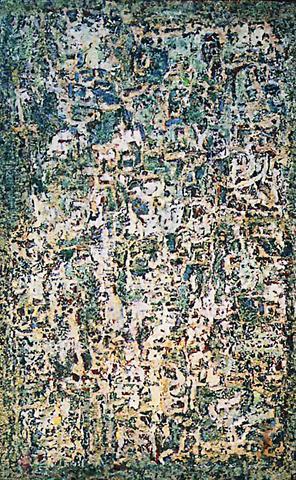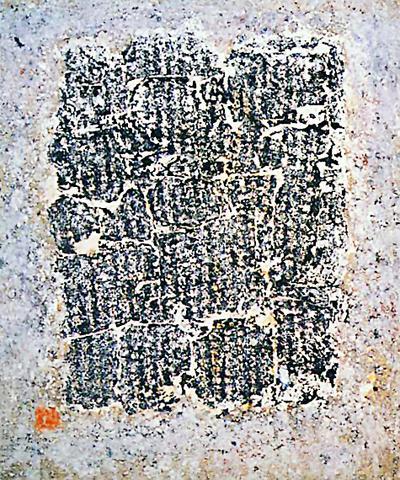When the 75-year-old George Chann held his solo exhibition, which proved to be his last, at a Los Angeles gallery in 1988, the local newspaper called him "a forgotten artist."
Indeed, Chann, the proprietor of Farmer's Market Art Gallery, who toiled a full eight hours every day at the easel in the back room of his shop for 40 years, hardly sold any work during his lifetime.
It was only after the Chinese ex-pat died in 1995 that his paintings slowly gained appreciation in the academic field and on the art market both here and abroad.

PHOTO COURTESY OF CITY GALLERY
After Chann's first posthumous exhibition, in Taipei in 2000, the life of the recluse began to unfold and his name started getting mentioned alongside those 20th century Chinese artists who were recognized much earlier, such as Sanyu (
In Chann's current exhibition, simply titled, "George Chann, Solo Exhibition" (
These Chinese calligraphy-incorporated abstract expressionist paintings are what Chann is most remembered for.

Chann started working in an abstract expressionist vein in the 1950s, when the school had become the mainstream of American modern art.
Although Chann once admitted in an interview to his admiration for abstract expressionist pioneers such as Mark Tobey and Jackson Pollock, he also realized that he had to explore different subjects and material if he was to develop his own style.
Chann did not have to look that far for inspiration, since his own art gallery -- not simply a display room for his own works, but a jewelry and Chinese artifacts shop -- had ample supply of calligraphy prints and rubbings taken from oracle bones, bronze vessels and steles.
According to art critic Wang Chia-chi's (
In many works, Chann made collages using these rearranged scripts on canvas. It was on these collages that the painter applied oil colors or, in some cases, wrote more calligraphy.
As if to create historical relics, Chann integrated fine sands on the painted surface to subtly imitate the time-worn veneer of artifacts.
These procedures resulted in some enchanting aspects to Chann's works.
While viewing an entire painting is enchanting, a closer look at the delicate traces of paint and the half-hidden elusive scripts, is as delightful as perusing a finely incised and naturally corroded Shang vessel. And in fact, the kind of azurite often found in the patina of Shang bronze is often an underlying color in Chann's paintings.
At the age of 12, Chann emigrated with his father from China's Guangdong province to California and was enrolled at the Otis Art Institute in Los Angles eight years later in 1934.
With a solid training in Impressionist techniques, Chann was an enthusiastic painter of the poverty of the blacks, Chinese and Mexicans, especially of the aged and orphaned among them.
Before Chann set up his art shop, he had good connections with several Los Angles dealers, and these works of social realism were frequently exhibited in his early years.
A less well-known line of painting Chann worked on involved scenes from the Bible. A Christian all his life, he donated 250 works to the Crystal Cathedral, near Los Angles, where they are now on permanent display.
George Chann Solo Exhibition runs until May 28 at Lin and Keng Gellery, No. 11, Lane 252, Tunhua S Rd., Sec 1 (

April 14 to April 20 In March 1947, Sising Katadrepan urged the government to drop the “high mountain people” (高山族) designation for Indigenous Taiwanese and refer to them as “Taiwan people” (台灣族). He considered the term derogatory, arguing that it made them sound like animals. The Taiwan Provincial Government agreed to stop using the term, stating that Indigenous Taiwanese suffered all sorts of discrimination and oppression under the Japanese and were forced to live in the mountains as outsiders to society. Now, under the new regime, they would be seen as equals, thus they should be henceforth

Last week, the the National Immigration Agency (NIA) told the legislature that more than 10,000 naturalized Taiwanese citizens from the People’s Republic of China (PRC) risked having their citizenship revoked if they failed to provide proof that they had renounced their Chinese household registration within the next three months. Renunciation is required under the Act Governing Relations Between the People of the Taiwan Area and the Mainland Area (臺灣地區與大陸地區人民關係條例), as amended in 2004, though it was only a legal requirement after 2000. Prior to that, it had been only an administrative requirement since the Nationality Act (國籍法) was established in

With over 80 works on display, this is Louise Bourgeois’ first solo show in Taiwan. Visitors are invited to traverse her world of love and hate, vengeance and acceptance, trauma and reconciliation. Dominating the entrance, the nine-foot-tall Crouching Spider (2003) greets visitors. The creature looms behind the glass facade, symbolic protector and gatekeeper to the intimate journey ahead. Bourgeois, best known for her giant spider sculptures, is one of the most influential artist of the twentieth century. Blending vulnerability and defiance through themes of sexuality, trauma and identity, her work reshaped the landscape of contemporary art with fearless honesty. “People are influenced by

The remains of this Japanese-era trail designed to protect the camphor industry make for a scenic day-hike, a fascinating overnight hike or a challenging multi-day adventure Maolin District (茂林) in Kaohsiung is well known for beautiful roadside scenery, waterfalls, the annual butterfly migration and indigenous culture. A lesser known but worthwhile destination here lies along the very top of the valley: the Liugui Security Path (六龜警備道). This relic of the Japanese era once isolated the Maolin valley from the outside world but now serves to draw tourists in. The path originally ran for about 50km, but not all of this trail is still easily walkable. The nicest section for a simple day hike is the heavily trafficked southern section above Maolin and Wanshan (萬山) villages. Remains of